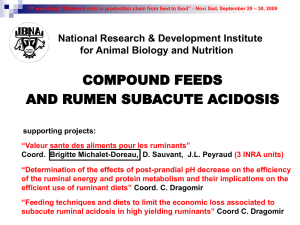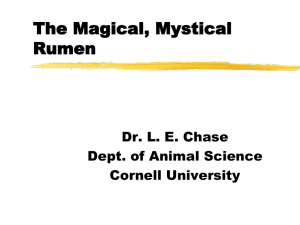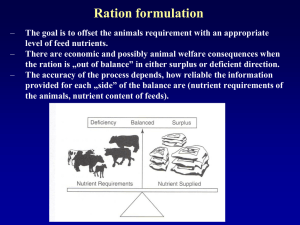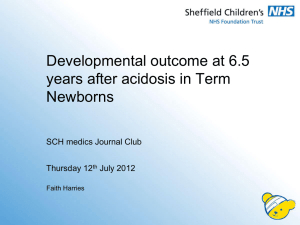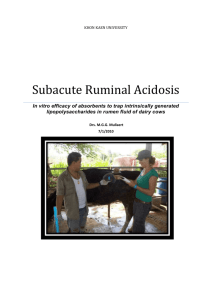Outline - University of Wisconsin School of Veterinary Medicine
advertisement
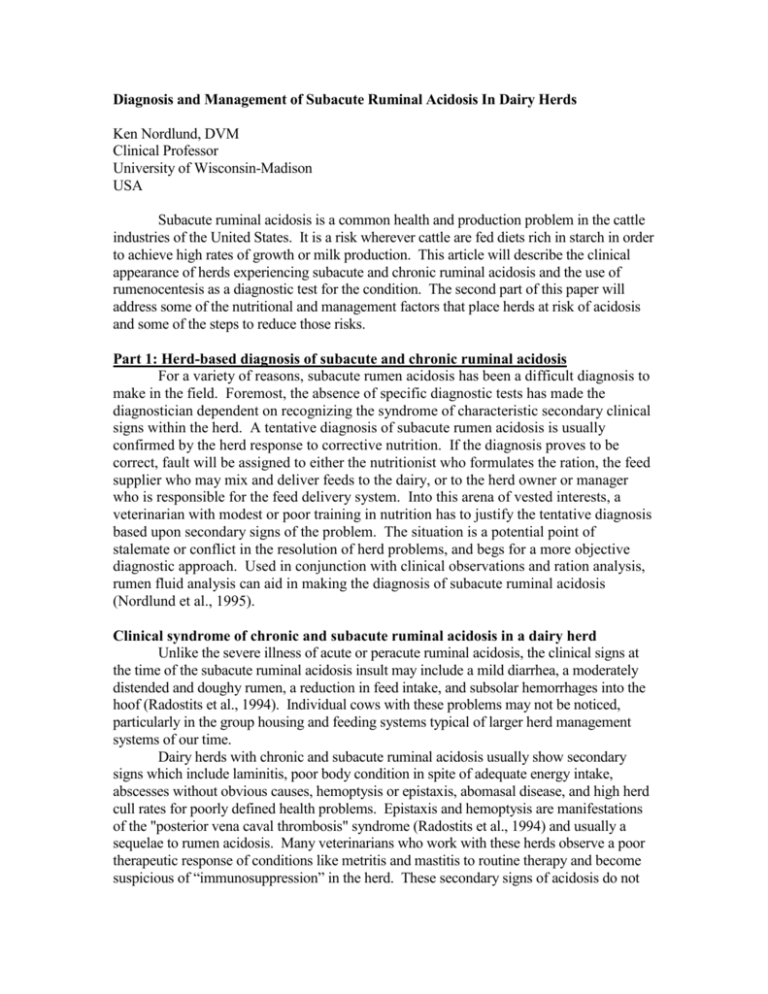
Diagnosis and Management of Subacute Ruminal Acidosis In Dairy Herds Ken Nordlund, DVM Clinical Professor University of Wisconsin-Madison USA Subacute ruminal acidosis is a common health and production problem in the cattle industries of the United States. It is a risk wherever cattle are fed diets rich in starch in order to achieve high rates of growth or milk production. This article will describe the clinical appearance of herds experiencing subacute and chronic ruminal acidosis and the use of rumenocentesis as a diagnostic test for the condition. The second part of this paper will address some of the nutritional and management factors that place herds at risk of acidosis and some of the steps to reduce those risks. Part 1: Herd-based diagnosis of subacute and chronic ruminal acidosis For a variety of reasons, subacute rumen acidosis has been a difficult diagnosis to make in the field. Foremost, the absence of specific diagnostic tests has made the diagnostician dependent on recognizing the syndrome of characteristic secondary clinical signs within the herd. A tentative diagnosis of subacute rumen acidosis is usually confirmed by the herd response to corrective nutrition. If the diagnosis proves to be correct, fault will be assigned to either the nutritionist who formulates the ration, the feed supplier who may mix and deliver feeds to the dairy, or to the herd owner or manager who is responsible for the feed delivery system. Into this arena of vested interests, a veterinarian with modest or poor training in nutrition has to justify the tentative diagnosis based upon secondary signs of the problem. The situation is a potential point of stalemate or conflict in the resolution of herd problems, and begs for a more objective diagnostic approach. Used in conjunction with clinical observations and ration analysis, rumen fluid analysis can aid in making the diagnosis of subacute ruminal acidosis (Nordlund et al., 1995). Clinical syndrome of chronic and subacute ruminal acidosis in a dairy herd Unlike the severe illness of acute or peracute ruminal acidosis, the clinical signs at the time of the subacute ruminal acidosis insult may include a mild diarrhea, a moderately distended and doughy rumen, a reduction in feed intake, and subsolar hemorrhages into the hoof (Radostits et al., 1994). Individual cows with these problems may not be noticed, particularly in the group housing and feeding systems typical of larger herd management systems of our time. Dairy herds with chronic and subacute ruminal acidosis usually show secondary signs which include laminitis, poor body condition in spite of adequate energy intake, abscesses without obvious causes, hemoptysis or epistaxis, abomasal disease, and high herd cull rates for poorly defined health problems. Epistaxis and hemoptysis are manifestations of the "posterior vena caval thrombosis" syndrome (Radostits et al., 1994) and usually a sequelae to rumen acidosis. Many veterinarians who work with these herds observe a poor therapeutic response of conditions like metritis and mastitis to routine therapy and become suspicious of “immunosuppression” in the herd. These secondary signs of acidosis do not appear until weeks or months after the causative events. A herd profile of the characteristic secondary clinical signs can be strongly suggestive of subacute acidosis, but each sign by itself could have other causes. Ration analysis A careful analysis of the herd rations is certainly a useful diagnostic procedure. In the nutrient system used in the US, particular attention is given to the amounts of acid detergent fiber, neutral detergent fiber, non-fiber carbohydrates, added fat, and crude protein. However, a tentative diagnosis of ruminal acidosis should not be ruled out based upon the ration analysis alone. There are two problems with an emphasis on the ration analysis. First, the ration printout does not always reflect the ration that the cows consume. It is sometimes difficult or impossible to accurately measure the actual consumption of ration components which makes the nutrient analysis into guesswork. Second, even if the ration is accurately described, the nutrient analysis does not fully predict what will happen in the rumen. In addition to the nutrient content of the ration, rumen pH will depend upon total intake, particle size, moisture, consumption patterns, and many other confounding factors. Several of these factors will be discussed in part two of this paper. Herd milk fat % “Normal” herd average milk fat % has been commonly and inappropriately used to rule out ruminal acidosis in herds. Abnormal low milk fat % is frequently a result of acidosis, but can occur due to excess ration fat, ionophores, and other potential causes. However, many herds with normal average milk fat % have significant acidosis problems. This is particularly true if the herd acidosis problem affects primarily the periparturient cows. Early lactation cows are quite sensitive to ruminal acidosis, but milk fat % of these cows is not well related to ruminal pH. In herds with multiple rations, subgroups of the herd may experience ruminal acidosis and produce low fat milk, but their milk is pooled with the rest of the herd which may mask the effect. Rumen fluid analysis Oral collection of rumen fluid has been used for many years in research trials and for transfaunation of other cattle. Several devices such as the Dirksen probe and the Geishauser probe have made collection of moderate quantities of fluid feasible. However, samples collected orally become contaminated with variable quantities of saliva which limits their value for evaluating subacute ruminal acidosis. In addition, their use as a veterinary diagnostic instrument is awkward in that they do not fit readily into typical veterinary practice units used in the US and they are difficult to clean which makes them potential fomites of infectious agents from farm to farm. Rumenocentesis procedure Rumenocentesis, the collection of rumen fluid by percutaneous needle aspiration, has become a common diagnostic test in the United States. The technique has been described in detail (Nordlund and Garrett, 1994), but essentially involves inserting a needle into the ventral rumen and aspirating a sample of rumen fluid. Landmarks for the puncture site are the left side, on a horizontal line level with the top of the patella about 15 to 20 cm posterior to the last rib. The site is clipped and prepared using a standard three scrub surgical preparation. We do not use sedation or local anesthetics. Rather, the cow is restrained in a stanchion or head-lock and one assistant elevates the tail of the cow while another assistant inserts a “nose leader” and pulls the cow’s head to the right side. The clinician inserts the needle within a few seconds after the nose-leader is inserted. A 1.8 x 130 mm stainless steel needle1 is thrust through the skin, then into the rumen and fluid is collected with very slight aspiration. The needle will usually become obstructed by ingesta which is cleared by forcing a small volume of air or fluid back through the needle. When the needle becomes obstructed, it is important to avoid creating a negative pressure within the syringe as CO2 will leave the fluid and increase the pH. Typically, 3 to 5 ml of rumen fluid can be collected with minimal difficulty. When a sufficient volume has been obtained, air is evacuated from the syringe and pH is measured immediately. Time of sample collection relative to feeding Samples should be collected at a time when rumen pH is likely to be near the lowest point of the day. If the ration is fed as separate components, rumenocentesis should be performed between 2 to 4 hours after the cow is offered the primary concentrate meal of the day. If the ration is fed as a total mixed ration (TMR), the samples should be collected at 4 to 8 hours after the cows get access to the fresh ration. pH determination The use of a pH meter is recommended for the measurement. We have not made a complete survey of pH meters, but of the meters we have used, we recommend the Cardy Twin pH meter manufactured by Horiba2. It is small, durable, and packed in a field case. It has a digital read-out, can function with just a few drops of fluid, and is equipped with a computerized calibration routine. In field use, we calibrate the meter using standard solutions of pH 4.0 and 7.0, read the samples, and then check accuracy of readings using the standard solutions again. The alternative of pH indicator paper is problematic in that the gradations on the narrowest papers we can find are 0.3 pH units. Frequently, the color cannot be matched to a single reference value. The combination of greenish rumen fluid and poor lighting in many barns present additional practical problems for pH papers. While there are advantages in communication of results if the readings are done cowside, the samples can be collected and held cold for pH analysis later. We measured pH of 18 samples on farm, kept the remainder on ice in capped plastic syringes from which air was expressed, and retested in 7 hours. The mean change in pH was less than 0.05 pH units and did not change the diagnostic classification of any animal or group. This limited analysis suggests that the samples, if kept cold, can be held for pH determination in a laboratory later that day. 1 Belanox 1.80 x 130 mm stainless steel needles, Jørgen Kruuse A/S, Marslev, Denmark 2 Spectrum Technologies, Inc., Plainfield, Illinois 60544, USA, Telephone 815-436-4440 Interpretation of results Based upon literature reviews of rumen fiber digestion and our clinical impressions from using the rumenocentesis test in investigations of acidotic herds, we recommended a pH of 5.50 as the cut-point between normal and abnormal (Nordlund and Garrett, 1994). Since that time, prospective studies have identified pH of 5.5 as the best cut-point to distinguish normal and fiber-deficient rations. (Garrett et al., 1999) Our guideline is that if 30% of 10 or more sampled cows are below 5.50, the group is classified as experiencing ruminal acidosis. It is important to avoid making a herd diagnosis based upon a few samples. We recommend that 10 or more cows should be sampled from any group in which acidosis is suspected. In a feeding trial of with a normal and a fiber deficient ration, we found a prevalence of 8% of the rumen samples below pH 5.50 in the “normal” high production ration and a prevalence of 40% below 5.50 in the “acidosis” ration. With these distributions of pH values, the interpretive guidelines offered above will be correct more than 95% of the time (Garrett et al., 1999). Effect of method of rumen fluid collection The method of collection has an effect on the pH of the sample. This should be kept in mind when reading rumen acidosis scientific reports. Samples collected by rumenocentesis have lower pH values than those collected by oral routes and through rumen cannula. Rumenocentesis samples were about 0.3 pH unites lower than rumen fluid collected simultaneously through rumen canal (Garrett et al., 1999). In a study not yet published comparing different collection methods, samples collected with the Geishauser tube were about 0.3 pH units higher and an indwelling rumen pH meter was about 0.1 pH units lower than the samples recovered through a rumen canal. Part 2: Factors that contribute to subacute and chronic ruminal acidosis In field investigations of suspected ruminal acidosis problems, we have found it practical to perform rumenocentesis on two groups of cows. The first group includes periparturient cows, usually between 3 to 20 days-in-milk. A diagnosis of subacute ruminal acidosis in this group will focus the investigation on ration adaptation problems and concentrate overfeeding to early lactation cows. The second group includes cows that are at or near peak milk. A diagnosis of subacute ruminal acidosis in this group will focus the investigation on ration formulation errors and feed delivery problems. By testing representative cows from each of these groups, a herd acidosis problem can be localized and identified quite efficiently. Periparturient cow factors Periparturient cows are at particular risk of ruminal acidosis because of two main reasons. First, the rumen and rumen microbes need to adapt from a very fibrous dry cow diet to the high energy lactation diet in a short period of time. Second, the periparturient cows reduces her intake of feed shortly before and after calving and many dairymen feed excess concentrates during this period of low intake. Adaptation to high starch rations Much research work on rumen acidosis has emphasized the adaptation of the rumen microbial population to increased levels of concentrates. Shifts of microbial populations include changes in the concentration of bacteria, as well as changes in the predominant genus and species. Bacteriological studies suggest that about 21 days are required to accomplish these changes and that concentrate levels should be increased at 5 to 7 day intervals throughout the period (Mackie and Gilchrist, 1979). Dirksen et al. (1985) have emphasized the importance of adaptive changes of the rumen mucosa in the prevention of acidosis. Mean surface area of rumen papillae will increase from 10 mm2 to 60 mm2 when exposed to high concentrate rations, but the process takes from four to six weeks. The larger surface area of adapted papillae is related to increased VFA absorption rates three times greater than rates for unadapted, smaller papillae. If papillae have not elongated, rumen pH can fall, not due to excess production, but because of accumulation in a rumen poorly prepared to remove VFA's. The take-home message is that the adaptation of microbes and papillae appropriate for a forage-predominant ration to a system capable of utilizing a high-energy lactation ration requires gradual changes over a period of more than three, and perhaps as much as six weeks of time. Management of the adaptation from dry cow to lactation rations As total mixed rations (TMR) have been increasingly adopted by smaller dairy herds in the upper Midwest, it has become a common practice to prepare one ration for the entire lactating herd. The single lactation TMR has made difficult the gradual introduction of concentrates to individual fresh cows in the weeks after calving. The single TMR can create acidosis problems for unadapted fresh cows and is necessitating the creation of transition rations between the dry cow and lactation ration. Guidelines as to the maximal acceptable change between rations are scarce. Elam (1976) has recommended that the net energy of a ration can be safely increased about 10% at a time. For example, a change from an energy density of 0.70 mcal/lb. to 0.77 mcal/LB would be viewed as safe. National Research Council (NRC) recommended dry cow rations would have 0.58 mcal/LB and many lactation TMR rations have 0.78 mcal/lb. (NRC, 1988). Observation of the 10% guideline would require two intermediate rations. However, practical experience suggests that most dry cow rations exceed 0.58 mcal/lb. The issue is not how many rations are fed. Rather, the issue is how great is the change. For example, if the early dry cow ration is estimated at 0.65 mcal/LB, a single intermediate ration accommodates the 10% guidelines. Periparturient depression of dry matter intake For years, dairy operators have been told to minimize the "negative energy balance" of early lactation and have attempted to maximize concentrate intake in early lactation. Field recommendations for the feeding of component-fed concentrates during the first three weeks are commonly excessive. For example, it is common to find cows fresh 7 days consuming 9 kg of dry matter from concentrates. Rations like these rarely meet the NRC (1988) fiber guidelines for early lactation cows because very little additional forage will be consumed. Cows at week one post-partum may be consuming only 13.5 kg DMI according to DMI prediction equations published by Kertz et al, (1991). Table 1 lists daily DMI for two example cows at each week post-partum for four weeks. Unlike the traditional prediction equations for DMI, these equations address the dynamic changes in intake in the immediate post-parturient period. Table 1. Dry matter intake predictions8 a b Week post-partum First lactation, 550 kg BWa, DMI,kg/day Later lactation, 614 kg BWb, DMI, kg/day 1 13 15 2 14.5 17 3 16 18.5 4 16.5 19.5 First lactation cow expected to peak at 36 kg of 3.5% fat milk Mature cow expected to peak at 45 kg of 3.5% fat milk Occasionally, the same situation applies to dry cows on component-fed "steamup" rations. Bertics et al. (1992) has shown significant reductions in DMI in the last few days prior to parturition. If component-fed concentrates are consumed and "free-choice" forages refused as DMI drops, the dry cow may experience acidosis prior to calving. Ration formulation and delivery factors Formulation issues The risk of rumen acidosis comes from the rapidly fermented carbohydrates of starch, sugar, and pectin. Because analyses of these non-fiber carbohydrates in feedstuffs are not readily available, ration analyses focus upon various fiber measurements that measure cell wall carbohydrates of lignin, cellulose, and sometimes hemicellulose. Recommendations for fiber content of dairy rations have been developed by the National Research Council (1988). Modifications of these recommendations for typical dairy rations in the Midwestern USA are found in Table 2 (Shaver, 1993). Table 2. Fiber guidelines for diets of lactating dairy cows Fiber analysis Minimum fiber as a % of dry matter Crude fiber 15-17 Acid detergent fiber 19-21 Neutral detergent fiber 27-30 Neutral detergent fiber from forage 21-22 The National Research Council (1988) recommend that fiber guidelines should be modified for fiber type, particle size and distribution, total dry matter intake, bulk density of ration, buffering capacity of the forage, feeding frequency, and body condition and production level of the animal. Practices such as excessive mixing of total mixed rations and infrequent feeding of large meals increase the fiber requirement of a ration, even though the chemical analysis of the ration meets recommended nutrient densities. Our field experience suggests that it is uncommon for ration advisors to modify fiber recommendations to account for any of these factors. Grain moisture and processing Any process that makes starch granules more available for microbial digestion increases the risk of ruminal acidosis. In most cases, increased processing increases digestibility and potential animal performance, but also increases the risk of acidosis. Fine grinding, heat and pressure treatments like steam flaking, and high moisture storage of any grain will make the ration more likely to cause acidosis than if the dry, coarsely ground form of the grain is fed (Owens et al., 1998) High fat content of the ration High fat diets reduce the number of protozoa in the rumen. Protozoa engulf starch particles, reduce rumen bacterial numbers, retard acid production, and stabilize ruminal fermentation (Slyter, 1976). High levels of added fat (over 0.9 kg/cow/day) can tip a fiber-marginal ration into a problem zone. Buffering capacity of feeds Legume forages and high protein feeds have more buffering capacity than grains, low protein feeds and grass forages (Jasaitis, 1987). Two rations formulated to the same nutrient specifications, one based on grass silage and another based on alfalfa silage, will have different buffering capacities and cows on the alfalfa ration will be less likely to experience acidosis. Short forage particle size Forages that have been reduced to small particles will be less effective in stimulating rumination which will result in less saliva production. For example, cows produced 0.94 ml saliva/g of fresh grass, 1.13 ml/g of silage, and 3.25 ml/g of dried grass hay (Bailey, 1958). Many nutritional advisors in the US carry particle separation boxes and have made particle size analysis a routine part of their service to dairy farms. The method focuses upon the proportion of “coarse particles” in the feed, that is, particles that remain on the screen with holes of 3.8 cm diameters. General guidelines have been developed for alfalfa silage that suggest that 15-25% of the forage should remain on the coarse screen. Guidelines for corn silage are less well developed, but many advisors have a goal of 5-10% of the corn silage as coarse particles. Similarly, the usual target for TMR samples is 7-10% of the complete ration on the coarse screen. Sometimes the TMR fails this test because of the component silages that go into the mixer, but sometimes they fail because of excessive mixing times. High dry matter intake Ruminal pH is profoundly influenced by the total intake of ration. In unpublished data where the same TMR diet was fed at different rates, mean daily ruminal pH averaged 5.7 on the high intake group and 6.1 on the group where intake was limited to 75% of the high group intake. The take-home point is that as dairy genetics gives us cows capable of eating more and more feed, the risk of acidosis will continue to increase even though the same ration is fed. Rapid increases in feed intake It is common for researchers to induce ruminal acidosis by withholding feed for a period of 12 hours and then allow hungry animals to eat up to 150% of their normal day’s ration. Situations where the interval between meals is increased will place the herd at risk of subacute acidosis. In hot weather, cows sometimes avoid the feedbunk during the day, but overeat in the cooler nighttime hours. Rapid increases in barometric pressure or reductions in humidity may stimulate cows to overeat and experience acidosis. Some sophisticated dairy managers have placed rules to the feeders that total feed intake per cow cannot be increased more than 5% in any single day, regardless of the appearance of the feedbunks. Unbalanced TMR’s due to feed moisture changes Deviations from the desired ration nutrient content commonly occur because of failure to adjust for changes in the moisture content of forages. Our field experience suggests that a minority of TMR operators monitor moisture of forages on an at-least weekly basis. The majority of dairy operators do not monitor moisture, but observe the rate at which cows clean up the bunk and adjust the forage weight of the next batch. In the upper Midwest, the predominant forage is alfalfa haylage. If cows clean up the TMR feeding quickly, the weight of as-fed haylage is increased in the next batch mix. Conversely, if TMR is left, forage is reduced in the following batch. The practice is conceptually correct if the observed change in consumption is due to dry matter changes in the forage. However, if the change in consumption is due to anything other than the forage dry matter, the subsequent adjustments are incorrect. If the group of cows reduces its DMI and the dairy operator subsequently reduces haylage in the TMR, the ration usually becomes fiber deficient. Routine monitoring of the dry matter content of feed ingredients is an important task of TMR management. The usual objection to monitoring forage dry matter is the time required to perform the test. Dairy extension services commonly recommend the use of a microwave oven for the determination. Oetzel et al. (1993) have compared a variety of methods. The use of an electronic meter (1210 Silage Tester; Farmex Inc., Aurora, OH) required the least operator skill and time, and accuracy was acceptable for haylage and highmoisture shelled corn. The electronic tester can help overcome objections to performing the test and reduce the risk of inappropriate TMR adjustments. Delivery system factors with component-fed systems Field investigators have long recognized the special risks of acidosis of component-fed rations. The risk of acidosis is reduced if the concentrate portion of the ration is 3 or 4 smaller portions per day, rather than larger portions delivered in two feedings. Anecdotal information abounds about the impact of feeding sequence on acidosis. The general opinion is that some quantity of forage should be fed prior to concentrate meals, particularly in the morning feeding. We have observed problems with subacute acidosis when the interval between the morning concentrate feeding and a subsequent forage feeding exceeds two hours. Some component feeding systems deliver forages in a competitive bunk area, but offer concentrates in individual stalls. This can place younger, timid cows at risk as they can consume full feedings of concentrates, but less forage than needed. Bibliography Bailey, C.B. 1958. As cited on p. 248 in Nutritional Ecology of the Ruminant, 2nd Edition, P.J. Van Soest, Cornell University Press, 1994. Bertics, S. J., R. R. Grummer, C. Cadorniga-Valino, and E. E. Stoddard. 1992. Effects of prepartum dry matter intake on liver triglyceride concentration and early lactation. J. Dairy Sci.75:1914. Dirksen, G.U., H.G. Liebich, and E. Mayer. 1985. Adaptive Changes of the Ruminal Mucosa and Their Functional and Clinical Significance. The Bovine Practitioner 20:116. Elam CJ. Acidosis in Feedlot Cattle: Practical Observations. 1976. J. Animal Sci. 43:898. Garrett, E. F., M. N. Pereira, L. E. Armentano, K. V. Nordlund, and G. R. Oetzel. 1995. Comparison of pH and VFA concentration of rumen fluid from dairy cows collected through a rumen canal vs. rumenocentesis. J. Dairy Sci. 78 (Supp 1):229. Garrett, E.F., M.N. Pereira, K.V. Nordlund, L.E. Armentano, W.J. Goodger, and G.R. Oetzel. Diagnostic Methods for Detecting Subacute Ruminal Acidosis in Dairy Cattle. J. Dairy Sci. 1999 (in press). Jasaitis, D.K., J.E. Wohlt, and J. L. Evans. 1987. Influence of feed ion content on buffering capacity of ruminant feedstuffs in vitro. J. Dairy Sci. 70:1391. Kertz, A.F,, L. F. Reutzel, and G. M. Thomson. 1991. Dry Matter Intake from Parturition to Midlactation. J. Dairy Sci. 74:2290. Mackie, R.I., and F.M.C. Gilchrist. 1979. Changes in Lactate-Producing and LactateUtilizing Bacteria in Relation to pH in the Rumen of Sheep During Stepwise Adaptation to a High-Concentrate Diet. Appl. Envir. Microbiology 38:422. National Research Council. 1988. Nutrient Requirements of Dairy Cattle, ed. 6. Washington, D.C., National Academy Press, p 147. Nordlund K. V. and E. F. Garrett. 1994. Rumenocentesis: a technique for the diagnosis of subacute rumen acidosis in dairy herds. Bovine Practitioner 28:104. Nordlund, K.V., Garrett, E.F., and G. R. Oetzel. 1995. Herd-based rumenocentesis: a clinical approach to the diagnosis of subacute rumen acidosis in dairy herds. Compendium Contin Educ Pract Vet. 17(8): S48-56. Oetzel, G. R., F. P. Villalba, W. J. Goodger, and K. V. Nordlund. 1993. A Comparison of On-Farm Methods for Estimating the Dry Matter Content of Feed Ingredients. J. Dairy Sci. 76:293. Owens, F.N., D.S. Secrist, W.J. Hill, and D.R.Gill. 1998. J. Animal Sci. 76:275-286. Radostits, O. M., D. C. Blood, and C. C. Gay. 1994. Veterinary Medicine, ed. 8. London, Bailliere Tindall, p. 256. Shaver, R. 1993. Troubleshooting problems with carbohydrates in dairy rations. Vet. Med. Oct:1001. Slyter, L.L. 1976. Influence of acidosis on rumen function. J. Animal Sci. 43:910-929.
